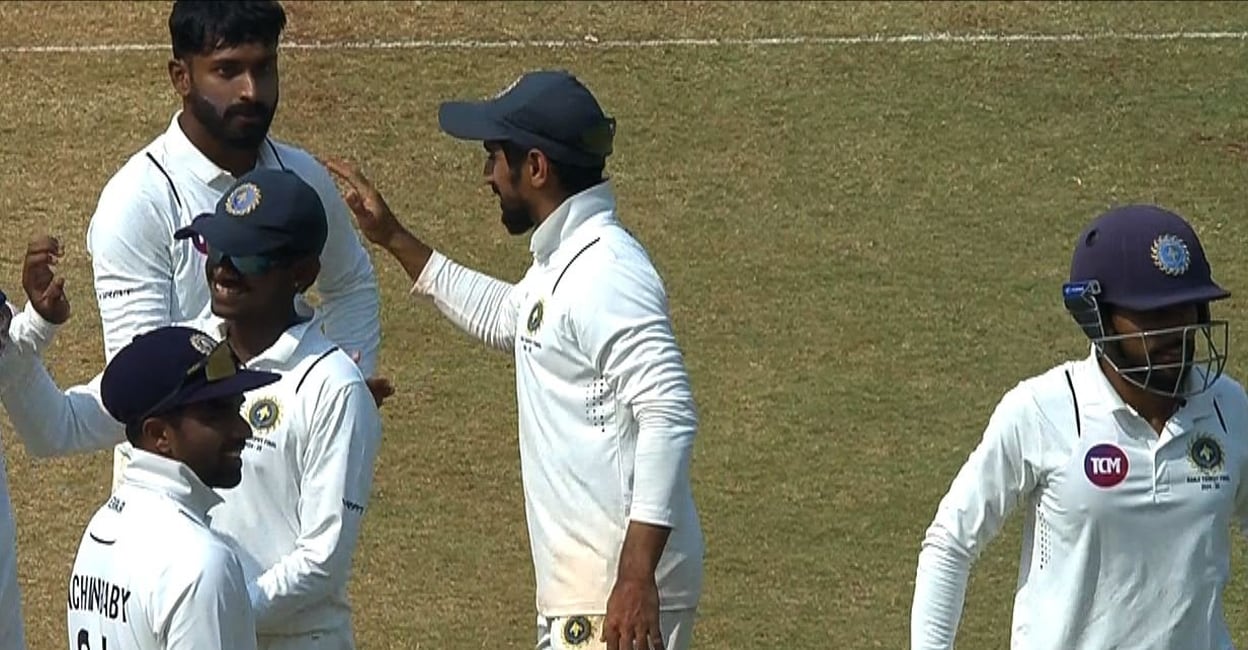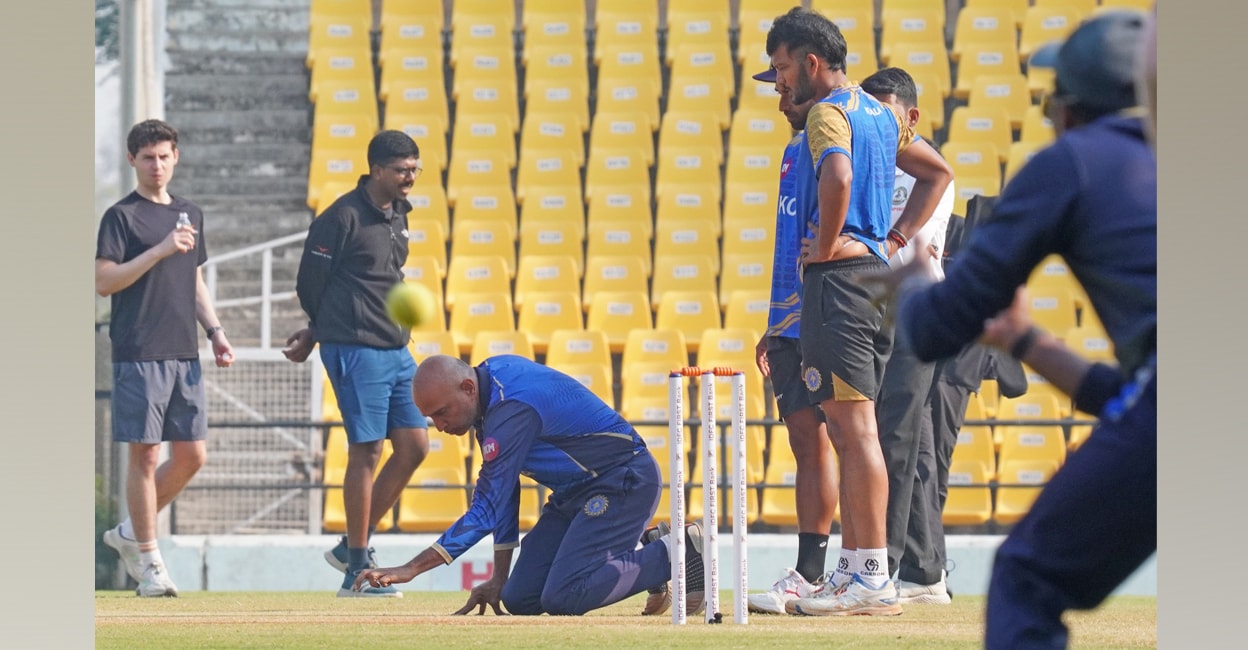If only ... how Kerala failed to win the Ranji Trophy final

Mail This Article
After Vidarbha clinched the Ranji Trophy title in Nagpur on Sunday, Kerala captain Sachin Baby said: "In the final, whoever makes fewer mistakes wins. We made more mistakes than Vidarbha."
Commentator Vivek Razdan, who hosted the post-match presentation ceremony, wanted specifics from the losing captain. "I'll take the blame for my shot," Sachin's response satisfied the former India bowler.
When the Kerala camp looks back at the moments they slipped up in their first Ranji final, they should find that inscrutable shot on top of the list. Before that fateful shot, Kerala were 324/6, just 55 runs short of Vidarbha's 379.

Oh, Sachin
Sachin was on 98 off 234 deliveries, batting alongside the veteran Jalaj Saxena, with the duo stitching up a 44-run partnership and looking confident of scaling Vidarbha's first-inning score. In Ranji, India's premier domestic red-ball tournament, first-innings lead amounts to a win in the case of a draw.
It is important to remember that Kerala advanced to the final by securing a 1-run lead against Jammu & Kashmir in the quarterfinals and a 2-run lead against Gujarat in the semifinals.
But with one wild swing of his bat at a Parth Rekhade delivery that was tossed up outside the off stump, Sachin not only threw away his wicket but also ended Kerala's chance of taking the precious lead. The remaining three Kerala wickets fell for just 18 runs, giving Vidarbha a vital 37-run lead.

But to be fair to Sachin, his rush of blood moment wasn't the only thing that cost Kerala a shot at the title. Below are a few other key moments that made the difference between winning and losing for Team Kerala.
Akshay drops Karun
In the 1999 World Cup, when South Africa's Herschelle Gibbs dropped Australia's Steve Waugh on 56, he essentially 'dropped the World Cup'. Waugh scored an unbeaten 120 to win the match for Australia and keep their World Cup alive. That drop later came to bite South Africa when the two sides tied in the semifinals, and Australia advanced because of their better finish in the Super Six stage thanks to Waugh's innings.
If that tournament could be compared with the Ranji final, Vidarbha's Karun Nair was Waugh and Kerala's Akshay Chandran was Gibbs. Chandran dropped Karun on 31 and the batter went on to make 135.

Fiery 19-year-old pacer Eden Apple Tom had bowled a beauty that sat up to the surprise of Karun, who had made up his mind to leave the delivery. But the ball clipped his glove and sailed toward the first slip. It was a sitter, but Chandran was too casual and dropped it. The Kerala opener, who regularly fields in the slips, had dropped one in the first innings, too, but this was big, and Kerala paid a heavy price.
Vidarbha's aggressive tail
The highlight of Vidarbha's first innings was a brilliant 215-run partnership for the fourth wicket between Danish Malewar (153) and Karun Nair (86). But there was an invaluable partnership between Nachiket Bhute and Harsh Dubey for Vidarbha's 10th wicket.
Vidarbha had collapsed from 290/5 to 335/9, the last wicket in that series was captain Akshay Wadkar, who got edged a length ball from Eden. Bhute, who was batting on 1, was joined by Harsh Dubey, and they only had one thing in mind: to score as much as possible. Bhute got a boundary off Eden and launched Jalaj Saxena over long off for a six. Dubey swept the veteran off-spinner for a boundary.

An over later, Bhute hit Saxena for another six and batted for four more overs, taking at least three singles on each occasion. When M D Nidheesh eventually dismissed Bhute (32 off 38), Vidarbha's last pair had added 44 runs. Dubey was unbeaten on 12 off 28. To put it into perspective, Kerala conceded a lead of 37 runs. Only if they had managed to put out Vidarbha's last pair of resistance sooner.
Kerala's timid tail
To complete the story, one must look at the approach adopted by Kerala's tailenders. Following Sachin's dismissal for 98, leaving Kerala on 324/7, Jalaj Saxena (batting on 21 off 36) was joined by Eden, the youngest member of the squad.

Kerala suddenly went into a shell. Eden's defensive approach was understandable, given he was batting for the first time in the season. Credit to the boy for showing he was just as able with the bat as with the new ball, with solid defence. But the surprise was Saxena's approach. The 38-year-old, who wears the mantra 'offence is the best form of defence' on his sleeve, added just 7 runs in 38 more deliveries he faced. Kerala added just 13 runs off the next 11 overs before Saxena was bowled by Rekhade (28 off 76).
Next up was Nidheesh, who had scored two 30s against Bihar and J&K, scoring at an average strike rate of 75. But he, too, shut the shop, blocking 10 deliveries before getting trapped leg before for 1. Clearly, the game plan was devised in the dugout. But why? What value did Amay Khurasiya find in batting passively when there was nothing to lose and everything (a lead) to gain?

The first aggressive shot, that fetchd a boundary for Eden, came after two maidens, but it was too late and the Kerala innings folded for 342, having added just 18 runs for their last three wickets.
Bowling, not aggressive enough?
Salman Nizar's dismissal on the third day gave a glimpse of what the Nagpur pitch had in store for spinners. Left-arm spinner Harsh Dubey pitched one on the rough outside off, and left-hander Salman padded it, offering no shot. An appeal went up and umpire Anil Chaudhary gave it out. Salman took the review, but he was unlucky; the ball tracker showed that the sharp turn would have grazed the wickets.
Vidarbha's other left-arm spinner, Parth Rekhade, also exploited the conditions. So, when Kerala came out to field, it was unsurprising that Sachin opened the bowling with his trusted off-spinner, Saxena.
The reward was instant, Saxena got Rekhade and pacer M D Nidheesh removed Dhurv Shorey, leaving Vidarbha reeling at 7/2 in 2.2 overs. Danish Malewar successfully reviewed against a leg before shout but it was clear that the wicket had much in store for Kerala's pacer and spinners alike.
But after Akshay Chandran dropped Karun Nair, the Vidarbha batters hardly found the surface troublesome. Between the dropped catch and Malewar's eventual dismissal in the 60th over, almost 65 per cent of Kerala's bowling was handled by the experienced pair of Saxena and Aditya Sarwate, but in vain. It took Chandran just four overs of his slower left-arm spin to get the breakthrough. But Chandran hardly got a spell longer than four overs. Vidarbha batted 88 more overs after the shaky start and lost just two more wickets on a surface that clearly had too much mystery hidden but seldom explored by the Kerala bowlers.

